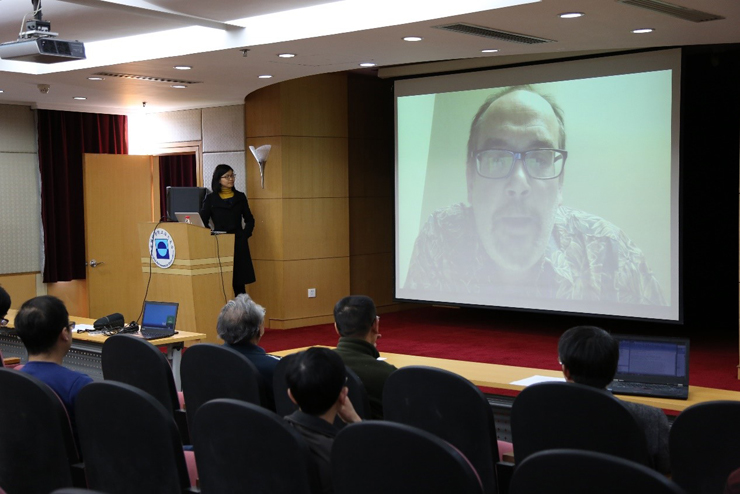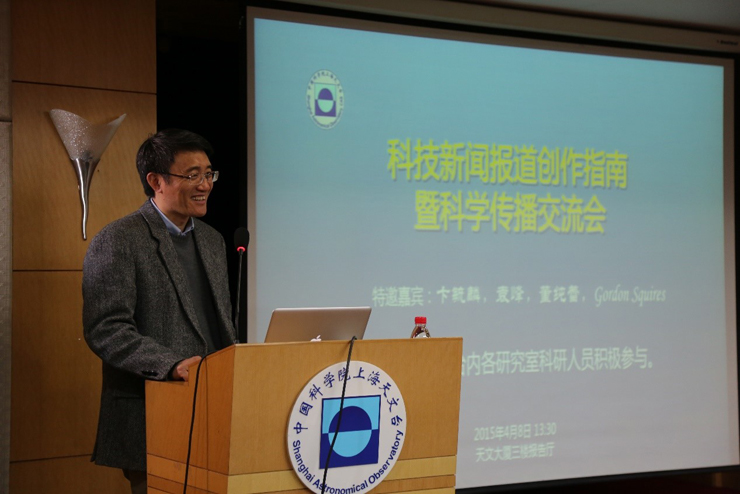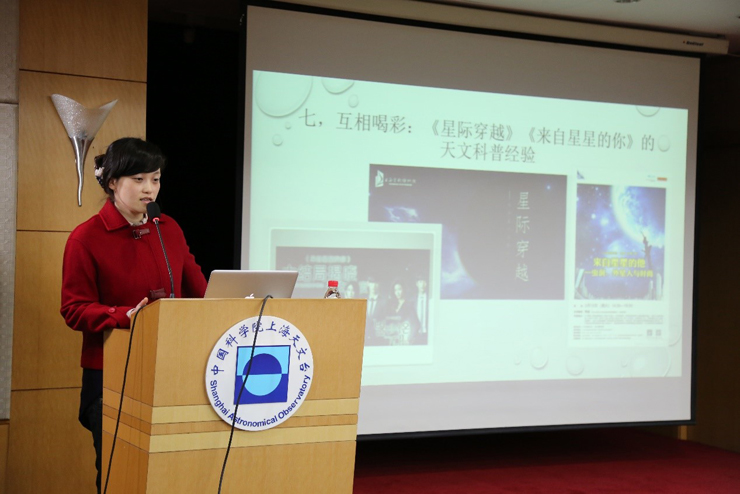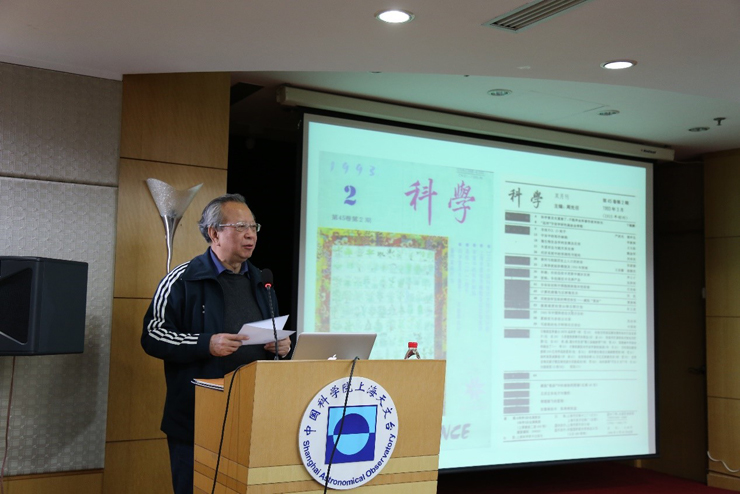A “grand banquet” of science communication organized by SHAO--- Seminar entitled as “Guide for science press release writing, Discussion about science communication”
On April 8, 2015, the Shanghai Astronomical Society and the Shanghai Astronomical Observatory (SHAO) ran a seminar to explain the current strategy and future plan of science communication and call for more researchers to provide more resources for science press release. This is the first seminar focusing on scientific press release writing and posting in Shanghai Astronomical Observatory, as the importance of posting scientific press release is more widely realized by researchers.
This seminar is entitled as “Guide for science press release writing, Discussion about science communication”. Researchers from SHAO attended this seminar. Invited speakers are respectively Prof. Yuan Feng (the director of research center for Galaxy and Cosmology in SHAO, research scientist), Prof. Bian Yulin (the vice president of the Chinese Science Writer’s Association), Dong Chunlei (the associate senior reporter of Xinmin Evening Paper) and Gordon Squires (the TMT International Observatory Communications and Education lead). All these invited speakers shared with audiences about their understanding of science communication and specifically science press release. Following are the detailed points mentioned by these speakers.
As a new friend of SHAO, especially a new friend of the public outreach office in SHAO, Gordon Squires specially recorded a greeting video for this seminar. In this 5-minute video, he mentioned how he built this friendship with SHAO and his hope for being able to read more science press releases about astronomy from China. “I had a wonderful stay in Shanghai and brilliant communication with audiences, especially people who are working in public outreach and education. Our teams are also working for a number of other astronomy projects, including Spitzer, Herschel, NuSTAR, NEOWISE, Planck, Kepler, and more. ” He said, “I hope we can start to build collaborations on international news reports on scientific progresses, if they are based on the programs that our team are working for. ”

Soon after Gordon’s video talk, a public outreach officer of SHAO, Dr. Wenwen Zuo, whose major is astrophysics, presented a brief introduction on how SHAO is working for science press release. “What we currently do is first to search for the newest paper written by SHAO researchers during this month. Then this paper will be digested by the writer herself to get a story and finally turned to be a preliminary press release draft. This draft will be further forwarded to the first author of this work for accuracy check.” Dr. Zuo said, “In this way, communication between the writer and the researchers is not well organized, which lead a long process of reading the paper and writing a draft. The final reported science progress has the problem of weak effectiveness, as the work has already been published for almost one month when public audiences read the press release.” She further added, most of the press releases were not in English, prohibiting journalists abroad to have an effective way of knowing the scientific progress of Chinese astronomers. However, more emphasis will be placed to international scientific news writing and posting, thanks to the inspiration of TMT science communication and education team.
The main contents of scientific press releases being the newest scientific progresses, comments from scientists are definitely placed in an important position. Prof. Yuan Feng said, “Both scientific research and science communication are important. Scientific research contributes to promote the development of science and technology. It can also satisfy human curiosity. One responsibility of researchers is to popularize knowledge and satisfy curiosity of public audiences.”

If we take the whole process of science press release writing and posting in SHAO as a relay race, researchers are the lead-off man, public outreach team is the next one and maybe the media journalists are the third, in certain circumstances. The journalist Dong Chunlei, who has worked in news reports of science & technology for about 10 years, shared her understanding of science press news and the relationships between researchers and media journalists. “Researchers and media journalists can and should have a relation like ‘partner genes’. The potential for collaboration between them should be actively explored.”

The last talk given by Prof. Bian Yulin brought on the crucial point. As an astronomer, science writer, translator and editor, Prof. Bian briefly summarized his work on research and public outreach. For this seminar, he recommended us his four papers about scientific communication and scientific polarization, i.e., “scientific communication is so important”, “six comments on scientific propaganda”, “nine chapters about the pursuit of scientific communication” and “vocation and promotion of scientific consciousness --- thoughts after re-reading <The Ideal of a Patriotic Scientist --- Collected Works of Ren Hong-Jun> and celebration for the 100-year birthday for the Science Society of China”. He concluded, “It is important to carry out scientific propaganda. From the aspect of science itself, it will help to promote the current development of science and cultivate the next generation of science talents. From the aspect of the whole society, it will help to build the material, ideological and spiritual culture. ‘Knowledge is strength’. To turn ‘knowledge’ to be ‘strength’ of people and the country, we have to investigate whether knowledge propaganda is conducted and what the depth and width of the propaganda are.”

At the end of seminar, discussions between the audiences and all the speakers were still going on. Some researchers asked more detailed questions on how to collaborate with the public outreach officers in SHAO.
To achieve a goal enabling more researchers to engage in writing scientific press releases in SHAO, to let scientific progresses known by audiences in China and abroad, this seminar is just a beginning.
Download attachments:


